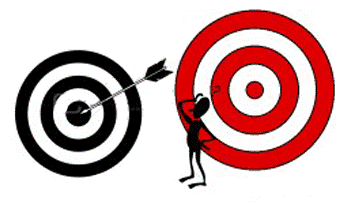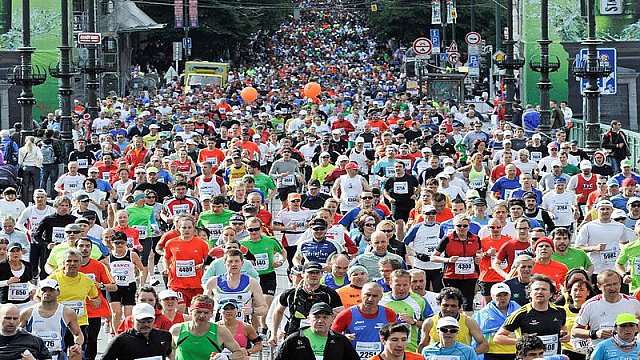One of the requirements to following Live It NOT Diet! is throwing your scale in the garbage. Mainly because the number is useless – telling you nothing about your body composition (fat-to-muscle) – but also because it messes with your mental state – giving you the impression that you’re not losing (or even gaining), and frustrating you to the point where you want to give up. Or worse, sending you back to the calorie restriction yo-yo diet that made you prone to gaining in the first place.
Fortunately, that’s not what this post is about. Although, based on the results from this new measurement tool, you could say it’s doing the same thing – messing with your mind, and pushing you towards a bullseye on the wrong target!

Ketone strips and meters have essentially become the new scale; giving people the false impression that being in ketosis (like losing weight) means they’re burning fat, and that not being in ketosis (like not losing weight) means they’re not burning any. When in actuality:
You can gain fat while being in ketosis, and you can lose fat without being in ketosis.
“Say What!!??”
Yes, you heard me right – fat can be stored in ketosis, and fat can be released without being in ketosis. Which is a concept best explained by looking at a visual I borrowed from Dr. Peter Attia at EatingAcademy.com (Thanks Doc!)

Without going into too much detail, the red arrow represents excess carbohydrates converted to fat in the liver and stored, the blue arrow represents dietary fat (or fat released from fat tissue) that’s stored, the green arrow represents fat getting released from fat tissue, and provided you’re output from the fat cell (green arrow) is greater than your inputs (red and blue arrow), you will lose fat.
DNL + RE < L = Lose Fat
Generally speaking, this happens with a low-carbohydrate diet because the red arrow is pretty much non-existent, and low-insulin helps the green arrow do it’s thing (by increasing glucagon) while preventing the blue arrow from storing much. So you could say anyone leaning towards eating less carbs and/or aiming for ketosis is well on the right track to losing fat.
HOWEVER, that’s provided they’re eating and living in a way that doesn’t shut down the green arrow. Because if that were to happen, they’d simply be burning dietary fat, and staying in ketosis, without actually liberating any stored fat. Which isn’t too far fetched if they’re supplying a consistent drip of dietary fat, and never getting into a fasted state, or they’re eating mounds of fat, but operating with the metabolic machinery of a turtle.
DNL + RE > L = Gain Fat
In other words, people seem to forget that dietary fat is a fuel source that is preferentially burned over stored fat. So whether glucose and insulin is present or not, you need to burn that before you burn anything else. And whether your meal was all fat or not, you still need to use that energy up before you start looking to your reserves (i.e. your body fat).

Similarly, they forget that energy supply is based on energy demand. Meaning, a lack of focus on nutrition, fitness and lifestyle factors that keep their resting metabolic rate elevated (protein, resistance training, sleep) will eventually result in a disproportionate blue arrow. Also known as “storing fat in ketosis.”
Interestingly, that last point is the reason I’m not a fan of this low protein ketogenic diet advice (among other things). As it implies eating more fat, but burning less daily energy. Since protein elevates our energy expenditure more than any other food (highest thermic effect), and protein builds the muscle that maximizes our daily energy expenditure (resting metabolic rate) going forward.
It’s also why I’m not a fan of this all-out-fat-eating, sticks-of-butter-business, that may keep you in ketosis, but does nothing for your waistline.

“Okay, but what about losing fat without being in ketosis?”
Great question. And the simple answer is that carbohydrate is present in the diet, but energy demands are larger than energy supply. Which despite what you’re thinking, has nothing to do with counting calories and over-exercising.
(As let’s be frank, I’m the last one to tell you do that!)
What it does involve is creating a bigger green arrow than blue and red arrow. And ideally, a bigger green arrow while sedentary (i.e. resting metabolic rate), so you’re not relying on excessive amounts of exercise on a daily basis.
…like everybody else.

As you may have guessed, this involves eating plenty of protein, and working out to build muscle. Since more protein means more energy expended after meals (thermic effect), more stimulation of glucagon (the hormone that liberates fat), and more muscle (raises RMR). While more resistance training means more muscle (raises RMR), and more room for glucose (stored as glycogen).
So, even if carbs are low-to-moderate, and you eat enough to briefly kick yourself out of ketosis, your green arrow is far larger than your non-lifting, protein-restricting keto counterparts, and you’ll still return to burning fat. Especially if you deliver your “good starch” in the post-workout period, when insulin will push it into muscle. And especially if you turn off the 24-hr energy drip, and start aiming for more food at less meals. As:
This will ensure you’re getting into the body-fat burning ketosis, instead of the dietary-fat burning ketosis.
Which is far better for your body composition, far better for your long-term health, and – if you’re smart enough to ditch the ketone strips – far better for your wallet and mental state.
Stay Lean!
Coach Mike
RELATED ARTICLES:
Eat More Meat, Burn More Fat. Period!
% of Calories or Not - It's a HIGH Protein Diet
Why Carbs Are Best Consumed AFTER Exercise
